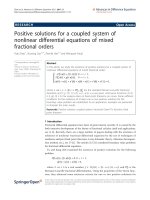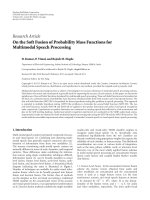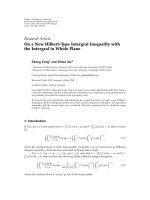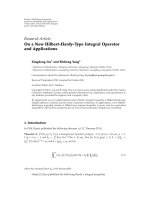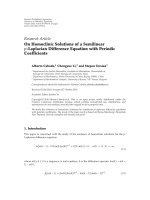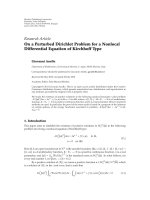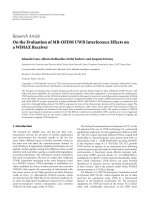Báo cáo hóa học: " Research Article On a k-Order System of Lyness-Type Difference Equations" doc
Bạn đang xem bản rút gọn của tài liệu. Xem và tải ngay bản đầy đủ của tài liệu tại đây (513.79 KB, 13 trang )
Hindawi Publishing Corporation
Advances in Difference Equations
Volume 2007, Article ID 31272, 13 pages
doi:10.1155/2007/31272
Research Article
On a k-Order System of Lyness-Type Difference Equations
G. Papaschinopoulos, C. J. Schinas, and G. Stefanidou
Received 17 January 2007; Revised 24 April 2007; Accepted 14 June 2007
Recommended by John R. Graef
We consider the following system of Lyness-type difference equations: x
1
(n +1)=
(a
k
x
k
(n)+b
k
)/x
k−1
(n − 1), x
2
(n +1)= (a
1
x
1
(n)+b
1
)/x
k
(n − 1), x
i
(n +1)=
(a
i−1
x
i−1
(n)+b
i−1
)/x
i−2
(n − 1), i = 3,4, ,k,wherea
i
, b
i
, i = 1,2, ,k, are positive con-
stants, k
≥ 3 is an integer, and the initial values are positive real numbers. We study the
existence of invariants, the boundedness, the persistence, and the periodicity of the p osi-
tive solutions of this system.
Copyright © 2007 G. Papaschinopoulos et al. This is an open access article distributed
under the Creative Commons Attribution License, which permits unrestricted use, dis-
tribution, and reproduction in any medium, provided the original work is properly cited.
1. Introduction
Difference equations and systems of difference equations have many applications in bi-
ology, economy, and other sciences. So there exist many papers concerning systems of
difference equations (see [1–10] a nd the references cited therein).
In [11], Koci
´
c and Ladas investigated the existence of invariants, the boundedness,
the persistence, the periodicity, and the oscillation of the positive solutions of the Lyness
difference equation
x
n+1
=
x
n
+ A
x
n−1
, n = 0,1, , (1.1)
where A is a positive constant and the initial conditions x
−1
, y
−1
, x
0
, y
0
are positive real
numbers.
2AdvancesinDifference Equations
In [6–8], the authors studied the behavior of the p ositive solutions of the system of
two Lyness difference equations
x
n+1
=
by
n
+ c
x
n−1
, y
n+1
=
dx
n
+ e
y
n−1
, n = 0,1, , (1.2)
where b, c, d, e are positive constants and the initial conditions x
−1
, y
−1
, x
0
, y
0
are positive
numbers.
Now in this paper, we consider the system of difference equations:
x
1
(n +1)=
a
k
x
k
(n)+b
k
x
k−1
(n −1)
,
x
2
(n +1)=
a
1
x
1
(n)+b
1
x
k
(n −1)
,
x
i
(n +1)=
a
i−1
x
i−1
(n)+b
i−1
x
i−2
(n −1)
, i
= 3,4, ,k,
(1.3)
where a
i
, b
i
, i = 1,2, ,k, are positive constant numbers, k ≥ 3 is an integer, and the
initial values x
i
(−1), x
i
(0), i = 1,2, ,k, are positive real numbers. For simplicity, system
(1.3)canbewrittenasfollows:
x
i
(n +1)=
a
i−1
x
i−1
(n)+b
i−1
x
i−2
(n −1)
, i
= 1,2, ,k, (1.4)
where
a
0
= a
k
, b
0
= b
k
, x
j
(n) = x
k+ j
(n), j =−1,0, n =−1,0, (1.5)
We study the existence of invariants, the boundedness, the persistence, and the periodicity
of the positive solutions of the system (1.3).
2. Boundedness and persistence
In this section, we study the boundedness and the persistence of the positive solutions of
(1.3). For this goal, we show the following proposition in w hich we find conditions so
that system (1.3) has an invariant.
Proposition 2.1. Let k
≥ 3 and
λ
k+i
= λ
i
, i ∈{−2,−1,0,1,2,3,4},
a
k+i
= a
i
, i ∈{−3,−2,−1,0,1},
b
k+i
= b
i
, i ∈{−2,−1,0}.
(2.1)
Assume that the system of 2k equations, with k unknowns λ
1
,λ
2
, ,λ
k
of the form
λ
i+2
b
i−1
+ λ
i+3
a
i
a
i−1
= λ
i−2
b
i−3
+ λ
i−3
a
i−4
a
i−3
, i ∈{1,2, ,k},
λ
i+4
a
i+1
b
i
= λ
i−1
a
i−2
b
i−1
, i ∈{1,2, ,k},
(2.2)
G. Papaschinopoulos et al. 3
has a nontriv ial solution λ
1
,λ
2
, λ
k
.Thensystem(1.3) has an invariant of the form
I
n
=
k
i=1
λ
i+2
x
i
(n)+
k
i=1
λ
i+2
x
i
(n −1)
+
k
i=1
λ
i
b
i−1
+ λ
i−1
a
i−1
a
i−2
1
x
i
(n)
+
k
i=1
λ
i
b
i−1
+ λ
i−1
a
i−1
a
i−2
1
x
i
(n −1)
+
k
i=1
λ
i−1
a
i−2
b
i−1
1
x
i
(n)x
i−1
(n −1)
+
k
i=1
λ
i
a
i−1
x
i−1
(n −1)
x
i
(n)
+
k
i=1
λ
i+3
a
i
x
i
(n)
x
i−1
(n −1)
.
(2.3)
Proof. From (1.5), (1.4), (2.1), (2.2), and (2.3), we have
I
n+1
=
k
i=1
λ
i+2
a
i−1
x
i−1
(n)
x
i−2
(n −1)
+
k
i=1
λ
i+2
b
i−1
1
x
i−2
(n −1)
+
k
i=1
λ
i+2
x
i
(n)
+
k
i=1
λ
i
b
i−1
+ λ
i−1
a
i−1
a
i−2
+ λ
i−1
a
i−2
b
i−1
1
x
i−1
(n)
+ λ
i
a
i−1
x
i−1
(n)
×
x
i−2
(n −1)
a
i−1
x
i−1
(n)+b
i−1
+
k
i=1
λ
i
b
i−1
+ λ
i−1
a
i−1
a
i−2
1
x
i
(n)
+
k
i=1
λ
i+3
a
i
a
i−1
1
x
i−2
(n −1)
+
k
i=1
λ
i+3
a
i
b
i−1
1
x
i−1
(n)x
i−2
(n −1)
=
k
i=1
λ
i+2
x
i
(n)+
k
i=1
λ
i
x
i−2
(n −1)
+
k
i=1
λ
i
b
i−1
+ λ
i−1
a
i−1
a
i−2
1
x
i
(n)
+
k
i=1
λ
i+2
b
i−1
+ λ
i+3
a
i
a
i−1
1
x
i−2
(n −1)
+
k
i=1
λ
i+3
a
i
b
i−1
1
x
i−1
(n)x
i−2
(n −1)
+
k
i=1
λ
i−1
a
i−2
x
i−2
(n −1)
x
i−1
(n)
+
k
i=1
λ
i+2
a
i−1
x
i−1
(n)
x
i−2
(n −1)
= I
n
.
(2.4)
This completes t he proof of the proposition.
4AdvancesinDifference Equations
Corollary 2.2. Let k
= 3.Thensystem(1.3)fork = 3 has the following invariant:
I
n
= b
1
x
1
(n)+b
2
x
2
(n)+b
3
x
3
(n)+b
1
x
1
(n −1) + b
2
x
2
(n −1)
+ b
3
x
3
(n −1) +
b
2
b
3
+ b
1
a
2
a
3
1
x
1
(n)
+
b
3
b
1
+ b
2
a
3
a
1
1
x
2
(n)
+
b
1
b
2
+ b
3
a
1
a
2
1
x
3
(n)
+
b
2
b
3
+ b
1
a
2
a
3
1
x
1
(n −1)
+
b
3
b
1
+ b
2
a
3
a
1
1
x
2
(n −1)
+
b
1
b
2
+ b
3
a
1
a
2
1
x
3
(n −1)
+ b
1
a
2
b
3
1
x
1
(n)x
3
(n −1)
+ b
2
a
3
b
1
1
x
2
(n)x
1
(n −1)
+ b
3
a
1
b
2
1
x
3
(n)x
2
(n −1)
+ b
2
a
3
x
3
(n −1)
x
1
(n)
+ b
3
a
1
x
1
(n −1)
x
2
(n)
+ b
1
a
2
x
2
(n −1)
x
3
(n)
+ b
2
a
1
x
1
(n)
x
3
(n −1)
+ b
3
a
2
x
2
(n)
x
1
(n −1)
+ b
1
a
3
x
3
(n)
x
2
(n −1)
.
(2.5)
Proof. From (2.1)and(2.2), we get λ
2
b
2
= λ
1
b
3
, λ
3
b
3
= λ
2
b
1
, λ
1
b
1
= λ
3
b
2
.Wesetλ
1
= b
2
,
λ
2
= b
3
, λ
3
= b
1
.Thenfrom(2.3), the proof follows immediately.
Corollary 2.3. Let k = 4.Supposethat
b
1
= b
2
= b
3
= b
4
= b. (2.6)
Then system (1.3)fork
= 4 has an invariant of the form
I
n
= a
1
x
1
(n)+a
2
x
2
(n)+a
3
x
3
(n)+a
4
x
4
(n)+a
1
x
1
(n −1)
+ a
2
x
2
(n −1) + a
3
x
3
(n −1) + a
4
x
4
(n −1) +
a
3
b + a
4
a
2
a
3
1
x
1
(n)
+
a
4
b + a
4
a
3
a
1
1
x
2
(n)
+
a
1
b + a
4
a
1
a
2
1
x
3
(n)
+
a
2
b + a
3
a
1
a
2
1
x
4
(n)
+
a
3
b + a
4
a
2
a
3
1
x
1
(n −1)
+
a
4
b + a
4
a
3
a
1
1
x
2
(n −1)
+
a
1
b + a
4
a
1
a
2
1
x
3
(n −1)
+
a
2
b + a
3
a
1
a
2
1
x
4
(n −1)
+ a
3
a
2
b
1
x
1
(n)x
4
(n −1)
+ a
3
a
4
b
1
x
2
(n)x
1
(n −1)
G. Papaschinopoulos et al. 5
+ a
1
a
4
b
1
x
3
(n)x
2
(n −1)
+ a
1
a
2
b
1
x
4
(n)x
3
(n −1)
+ a
1
a
4
x
1
(n −1)
x
2
(n)
+ a
1
a
2
x
2
(n −1)
x
3
(n)
+ a
3
a
2
x
3
(n −1)
x
4
(n)
+ a
3
a
4
x
4
(n −1)
x
1
(n)
+ a
1
a
4
x
4
(n)
x
3
(n −1)
+ a
3
a
4
x
3
(n)
x
2
(n −1)
+ a
3
a
2
x
2
(n)
x
1
(n −1)
+ a
1
a
2
x
1
(n)
x
4
(n −1)
.
(2.7)
Proof. From (2.1), (2.2), and (2.6), we obtain
λ
2
b + λ
3
a
4
a
3
= λ
2
b + λ
1
a
4
a
1
,
λ
1
b + λ
2
a
2
a
3
= λ
1
b + λ
4
a
4
a
3
,
λ
3
b + λ
4
a
4
a
1
= λ
3
b + λ
2
a
2
a
1
,
λ
4
b + λ
1
a
2
a
1
= λ
4
b + λ
3
a
2
a
3
,
λ
1
a
4
b = λ
2
a
3
b,
λ
2
a
1
b = λ
3
a
4
b,
λ
3
a
2
b = λ
4
a
1
b,
λ
4
a
3
b = λ
1
a
2
b.
(2.8)
We set in (2.8) λ
1
= a
3
, λ
2
= a
4
, λ
3
= a
1
, λ
4
= a
2
.Thenfrom(2.3), the proof follows
immediately.
Corollary 2.4. Consider system (1.3), w here k = 5.Supposethat
a
4
a
5
= b
2
,
a
3
a
2
= b
5
,
a
5
a
1
= b
3
,
a
4
a
3
= b
1
,
a
1
a
2
= b
4
.
(2.9)
Then system (1.3), with k = 5, has an invariant of the form
I
n
= λ
3
x
1
(n)+λ
4
x
2
(n)+λ
5
x
3
(n)+λ
1
x
4
(n)+λ
2
x
5
(n)
+ λ
3
x
1
(n −1) + λ
4
x
2
(n −1) + λ
5
x
3
(n −1)
+ λ
1
x
4
(n −1) + λ
2
x
5
(n −1)
+
λ
1
a
2
a
3
+ λ
5
a
4
a
5
1
x
1
(n)
+
λ
2
a
3
a
4
+ λ
1
a
5
a
1
1
x
2
(n)
6AdvancesinDifference Equations
+
λ
3
a
4
a
5
+ λ
2
a
1
a
2
1
x
3
(n)
+
λ
4
a
1
a
5
+ λ
3
a
2
a
3
1
x
4
(n)
+
λ
5
a
1
a
2
+ λ
4
a
3
a
4
1
x
5
(n)
+
λ
1
a
2
a
3
+ λ
5
a
4
a
5
1
x
1
(n −1)
+
λ
2
a
3
a
4
+ λ
1
a
5
a
1
1
x
2
(n −1)
+
λ
3
a
4
a
5
+ λ
2
a
1
a
2
1
x
3
(n −1)
+
λ
4
a
1
a
5
+ λ
3
a
2
a
3
1
x
4
(n −1)
+
λ
5
a
1
a
2
+ λ
4
a
3
a
4
1
x
5
(n −1)
+ λ
5
a
4
a
3
a
2
1
x
1
(n)x
5
(n −1)
+ λ
1
a
5
a
4
a
3
1
x
2
(n)x
1
(n −1)
+ λ
2
a
1
a
4
a
5
1
x
3
(n)x
2
(n −1)
+ λ
3
a
2
a
5
a
1
1
x
4
(n)x
3
(n −1)
+ λ
4
a
3
a
1
a
2
1
x
5
(n)x
4
(n −1)
+ λ
1
a
5
x
5
(n −1)
x
1
(n)
+ λ
2
a
1
x
1
(n −1)
x
2
(n)
+ λ
3
a
2
x
2
(n −1)
x
3
(n)
+ λ
4
a
3
x
3
(n −1)
x
4
(n)
+ λ
5
a
4
x
4
(n −1)
x
5
(n)
+ λ
4
a
1
x
1
(n)
x
5
(n −1)
+ λ
5
a
2
x
2
(n)
x
1
(n −1)
+ λ
1
a
3
x
3
(n)
x
2
(n −1)
+ λ
2
a
4
x
4
(n)
x
3
(n −1)
+ λ
3
a
5
x
5
(n)
x
4
(n −1)
,
(2.10)
where λ
i
, i = 1,2,3,4,5, are real numbers.
Proof. Using (2.1), (2.2), and (2.9), we get
λ
1
a
1
a
5
+ λ
2
a
4
a
3
= λ
2
a
3
a
4
+ λ
1
a
5
a
1
,
λ
2
a
2
a
1
+ λ
3
a
4
a
5
= λ
3
a
4
a
5
+ λ
2
a
1
a
2
,
λ
5
a
4
a
5
+ λ
1
a
3
a
2
= λ
1
a
2
a
3
+ λ
5
a
4
a
5
,
λ
3
a
3
a
2
+ λ
4
a
1
a
5
= λ
4
a
1
a
5
+ λ
3
a
2
a
3
,
λ
4
a
4
a
3
+ λ
5
a
2
a
1
= λ
5
a
1
a
2
+ λ
4
a
3
a
4
,
λ
1
a
3
a
4
a
5
= λ
1
a
3
a
4
a
5
,
λ
2
a
4
a
5
a
1
= λ
2
a
4
a
5
a
1
,
λ
3
a
5
a
1
a
2
= λ
3
a
5
a
1
a
2
,
λ
4
a
1
a
2
a
3
= λ
4
a
1
a
2
a
3
,
λ
5
a
2
a
3
a
4
= λ
5
a
2
a
3
a
4
,
(2.11)
G. Papaschinopoulos et al. 7
which are satisfied for any real numbers λ
i
, i = 1, 2,3,4,5. Then from (2.3), the corollary
is proved.
3. Periodicity
We study the periodicity of the positive solutions of (1.3) by investigating three cases:
k
= 3, k = 4, and k ∈{5,6, }. For the first case, we show the following proposition.
Proposition 3.1. Consider system (1.3)fork
= 3.If
a
1
= a
2
= a
3
= a,
b
1
= b
2
= b
3
= b,
a
2
= b,
(3.1)
then every positive solution of system (1.3) is periodic of period 15.
Proof. We have
x
1
(n +5)=
ax
3
(n +4)+a
2
x
2
(n +3)
=
a
ax
2
(n +3)+a
2
/x
1
(n +2)
+ a
2
x
2
(n +3)
=
a
2
x
2
(n +3)+a
3
+ a
2
x
1
(n +2)
x
1
(n +2)x
2
(n +3)
=
a
2
ax
1
(n +2)+a
2
/x
3
(n +1)
+ a
3
+ a
2
x
1
(n +2)
x
1
(n +2)((ax
1
(n +2)+a
2
)/x
3
(n +1))
=
a
3
x
1
(n +2)+a
4
+ a
3
x
3
(n +1)+a
2
x
1
(n +2)x
3
(n +1)
x
1
(n +2)
ax
1
(n +2)+a
2
=
ax
1
(n +2)+a
2
ax
3
(n +1)+a
2
x
1
(n +2)
ax
1
(n +2)+a
2
=
ax
3
(n +1)+a
2
x
1
(n +2)
= x
2
(n).
(3.2)
Working in a similar way, we can prove that
x
2
(n +5)= x
3
(n),
x
3
(n +5)= x
1
(n).
(3.3)
Thus,
x
1
(n +15) = x
2
(n +10) = x
3
(n +5)= x
1
(n). (3.4)
Similarly,
x
2
(n +15) = x
2
(n),
x
3
(n +15) = x
3
(n),
(3.5)
and the proof of the proposition is complete.
8AdvancesinDifference Equations
In the sequel, we prove the following proposition which concerns the case k
= 4.
Proposition 3.2. Consider system (1.3)fork
= 4.If
a
1
= a
2
= a
3
= a
4
= a,
b
1
= b
2
= b
3
= b
4
= b,
a
2
= b,
(3.6)
then every positive solution of system (1.3) is periodic of period 20.
Proof. We have
x
1
(n +5)=
ax
4
(n +4)+a
2
x
3
(n +3)
=
a
(ax
3
(n +3)+a
2
)/x
2
(n +2)
+ a
2
x
3
(n +3)
=
a
2
x
3
(n +3)+a
3
+ a
2
x
2
(n +2)
x
2
(n +2)x
3
(n +3)
=
a
2
ax
2
(n +2)+a
2
/x
1
(n +1)
+ a
3
+ a
2
x
2
(n +2)
x
2
(n +2)((ax
2
(n +2)+a
2
)/x
1
(n +1))
=
a
3
x
2
(n +2)+a
4
+ a
3
x
1
(n +1)+a
2
x
1
(n +1)x
2
(n +2)
x
2
(n +2)
ax
2
(n +2)+a
2
=
ax
2
(n +2)+a
2
ax
1
(n +1)+a
2
x
2
(n +2)
ax
2
(n +2)+a
2
=
ax
1
(n +1)+a
2
x
2
(n +2)
= x
4
(n).
(3.7)
Arguing as above, we can show that
x
2
(n +5)= x
1
(n),
x
3
(n +5)= x
2
(n),
x
4
(n +5)= x
3
(n).
(3.8)
So,
x
1
(n +20) = x
4
(n +15) = x
3
(n +10) = x
2
(n +5)= x
1
(n). (3.9)
Similarly,
x
2
(n +20) = x
2
(n),
x
3
(n +20) = x
3
(n),
x
4
(n +20) = x
4
(n),
(3.10)
and the proof of the proposition is complete.
G. Papaschinopoulos et al. 9
Finally, we study the case k
∈{5,6, }. To this end, we have at first to prove the fol-
lowing lemma.
Lemma 3.3. Let k
≥ 5.If
a
1
= a
2
=···= a
k
= a, b
1
= b
2
=···= b
k
= b, a
2
= b (3.11)
then
x
i
(n +5)= x
k−5+i
(n), i ∈{1,2, ,5},
x
i
(n +5)= x
i−5
(n), i ∈{6,7, ,k}.
(3.12)
Proof. From (1.3), we have
x
1
(n +5)=
ax
k
(n +4)+a
2
x
k−1
(n +3)
=
a
ax
k−1
(n +3)+a
2
/x
k−2
(n +2)
+ a
2
x
k−1
(n +3)
=
a
2
x
k−1
(n +3)+a
3
+ a
2
x
k−2
(n +2)
x
k−2
(n +2)x
k−1
(n +3)
=
a
2
ax
k−2
(n +2)+a
2
/x
k−3
(n +1)
+ a
3
+ a
2
x
k−2
(n +2)
x
k−2
(n +2)
ax
k−2
(n +2)+a
2
/x
k−3
(n +1)
=
a
3
x
k−2
(n +2)+a
4
+ a
3
x
k−3
(n +1)+a
2
x
k−2
(n +2)x
k−3
(n +1)
x
k−2
(n +2)
ax
k−2
(n +2)+a
2
=
ax
k−2
(n +2)+a
2
ax
k−3
(n +1)+a
2
x
k−2
(n +2)
ax
k−2
(n +2)+a
2
.
(3.13)
Then since, from (1.3),
x
k−4
(n) =
ax
k−3
(n +1)+a
2
x
k−2
(n +2)
, (3.14)
it follows that
x
1
(n +5)= x
k−4
(n). (3.15)
Similarly, we can prove that
x
i
(n +5)= x
k−5+i
(n), i ∈{2,3, ,5}. (3.16)
10 Advances in Difference Equations
Let i
∈{6,7, ,k}.Then
x
i
(n +5)=
ax
i−1
(n +4)+a
2
x
i−2
(n +3)
=
a
ax
i−2
(n +3)+a
2
/x
i−3
(n +2)
+ a
2
x
i−2
(n +3)
=
a
2
x
i−2
(n +3)+a
3
+ a
2
x
i−3
(n +2)
x
i−2
(n +3)x
i−3
(n +2)
=
a
2
ax
i−3
(n +2)+a
2
/x
i−4
(n +1)
+ a
3
+ a
2
x
i−3
(n +2)
x
i−3
(n +2)
ax
i−3
(n +2)+a
2
/x
i−4
(n +1)
=
a
3
x
i−3
(n +2)+a
4
+ a
3
x
i−4
(n +1)+a
2
x
i−3
(n +2)x
i−4
(n +1)
x
i−3
(n +2)
ax
i−3
(n +2)+a
2
=
ax
i−3
(n +2)+a
2
ax
i−4
(n +1)+a
2
x
i−3
(n +2)
ax
i−3
(n +2)+a
2
.
(3.17)
Then since, from (1.3),
x
i−5
(n) =
ax
i−4
(n +1)+a
2
x
i−3
(n +2)
, (3.18)
it follows that
x
i
(n +5)= x
i−5
(n), i ∈{6,7, ,k}. (3.19)
Now we can show the following proposition.
Proposition 3.4. Consider system (1.3), where k ≥ 5. Assume that relations (3.11)hold.
Then the following statements are t rue.
(i) Every positive solution of system (1.3) is periodic of period k if k
= 5r, r = 1, 2,
(ii) Every positive solution of system (1.3) is periodic of period 5k if k
= 5r, r = 1, 2,
Proof. Consider an arbitrary solution (x
1
(n), ,x
k
(n)) of (1.3).
(i) Suppose that k
= 5r, r = 1, 2, Thenfrom(3.12), we have
x
i
(n +5)= x
5r−5+i
(n), i ∈{1,2, ,5},
x
i
(n +5)= x
i−5
(n), i ∈{6,7, ,5r}.
(3.20)
We claim that for i
= 1,2, ,5,
x
i
(n +5s) = x
5r−5s+i
(n), s = 1,2, ,r. (3.21)
From (3.20), it is obvious that (3.21)istruefors
= 1. Suppose that for i = 1,2, ,5,
relation (3.21)istruefors
= 1,2, ,r − 1. Then since 6 ≤ 5r − 5s + i ≤ 5r,from(3.20)
and (3.21), we get for i
= 1,2, ,5,
x
i
(n +5+5s) = x
5r−5s+i
(n +5)= x
5r−5(s+1)+i
(n), (3.22)
G. Papaschinopoulos et al. 11
and so (3.21)istrue.Thenfrom(3.21)fors
= r,wehave
x
i
(n +5r) = x
i
(n), i = 1,2, ,5. (3.23)
Therefore the sequences x
i
(n), i = 1,2, ,5 are p eriodic of period 5. Then from (3.20),
all the sequences x
i
(n), i = 1,2, ,k, are periodic of period k.
(ii) Suppose that k
= 5r, r = 1,2, Letk = 5r +1,r = 1,2, Thenfrom(3.12), we
have
x
i
(n +5)= x
5r−4+i
(n), i ∈{1,2, ,5},
x
i
(n +5)= x
i−5
(n), i ∈{6,7, ,5r +1}.
(3.24)
Applying (3.24) and using the same argument to show (3.21), we can prove that for i
=
1,2, ,5
x
i
(n +5s) = x
5r−5s+i+1
(n), s = 1,2, ,r. (3.25)
So from (3.24)and(3.25)fori
= 1, s = r,weget
x
1
(n +25r +5)= x
2
(n +20r +5)= x
3
(n +15r +5)= x
4
(n +10r +5),
x
5
(n +5r +5)= x
6
(n +5)= x
1
(n).
(3.26)
Therefore x
1
(n) is a periodic sequence of period 5(5r +1)= 5k.Henceby(3.24), all the
sequences x
i
(n), i = 1,2, ,k, are periodic of period 5k.
Let k
= 5r +2.Thenfrom(3.12), we have
x
i
(n +5)= x
5r−3+i
(n), i ∈{1,2, ,5},
x
i
(n +5)= x
i−5
(n), i ∈{6,7, ,5r +2}.
(3.27)
Then from (3.27) and using the same argument to prove (3.21), we can prove that for
i
= 1,2, ,5,
x
i
(n +5s) = x
5r−5s+i+2
(n), s = 1,2, ,r. (3.28)
Then from (3.27)and(3.28)fori
= 1, s = r,weget
x
1
(n +25r + 10) = x
3
(n +20r + 10) = x
5
(n +15r + 10)
= x
7
(n +10r + 10) = x
2
(n +10r +5)= x
4
(n +5r +5)
= x
6
(n +5)= x
1
(n),
(3.29)
which implies that x
1
(n)isaperiodicsequenceofperiod5k. Then by relations (3.27), we
can prove that the sequences x
i
(n), i = 2,3, ,k, are periodic of period 5k.
Let k
= 5r +3.Thenfrom(3.12), we have
x
i
(n +5)= x
5r−2+i
(n), i ∈{1,2, ,5},
x
i
(n +5)= x
i−5
(n), i ∈{6,7, ,5r +3}.
(3.30)
12 Advances in Difference Equations
Then from (3.30) and using the same argument to show (3.21), we can prove that for
i
= 1,2, ,5,
x
i
(n +5s) = x
5r−5s+i+3
(n), s = 1,2, ,r. (3.31)
Then from (3.30)and(3.31)fori = 1, s = r,weget
x
1
(n +25r + 15) = x
4
(n +20r + 15) = x
7
(n +15r + 15)
= x
2
(n +15r + 10) = x
5
(n +10r + 10)
= x
8
(n +5r + 10) = x
3
(n +5r +5)= x
6
(n +5)= x
1
(n),
(3.32)
which implies that x
1
(n) is a periodic sequence of period 5(5r +3)= 5k.Thenfromre-
lations (3.30), we can prove that the sequences x
i
(n), i = 1,2, , k, are periodic of period
5k.
Let k
= 5r +4.Thenfrom(3.12), we have
x
i
(n +5)= x
5r−1+i
(n), i ∈{1,2, ,5},
x
i
(n +5)= x
i−5
(n), i ∈{6,7, ,5r +4}.
(3.33)
Then from (3.33) and using the same argument to show (3.21), we can prove that for
i
= 1,2, ,5,
x
i
(n +5s) = x
5r−5s+i+4
(n), s = 1,2, ,r. (3.34)
Then from (3.33)and(3.34)fori = 1, s = r,weget
x
1
(n +25r + 20) = x
5
(n +20r + 20) = x
9
(n +15r + 20)
= x
4
(n +15r + 15) = x
8
(n +10r + 15) = x
3
(n +10r + 10)
= x
7
(n +5r + 10) = x
2
(n +5r +5)= x
6
(n +5)= x
1
(n),
(3.35)
which implies that x
1
(n) is a periodic sequence of period 5(5r +4)= 5k.Thenfromre-
lations (3.33), we can prove that the sequences x
i
(n), i = 1,2, , k, are periodic of period
5k. This completes the proof of the proposition.
Acknowledgment
The authors would like to thank the referee for their helpful suggestions.
References
[1] D.ClarkandM.R.S.Kulenovi
´
c, “A coupled system of rational difference equations,” Computers
& Mathematics w ith Applications, vol. 43, no. 6-7, pp. 849–867, 2002.
[2]D.Clark,M.R.S.Kulenovi
´
c, and J. F. Selgrade, “Global asymptotic behavior of a two-
dimensional difference equation modelling competition,” Nonlinear Analysis: Theory, Methods,
&Applications, vol. 52, no. 7, pp. 1765–1776, 2003.
[3] M.R.S.Kulenovi
´
c and O. Merino, Discrete Dynamical Systems and Difference Equations with
Mathematica, Chapman & Hall/CRC, Boca Raton, Fla, USA, 2002.
G. Papaschinopoulos et al. 13
[4] M.R.S.Kulenovi
´
c and Z. Nurkanovi
´
c, “Global behavior of a three-dimensional linear fractional
system of difference equations,” Journal of Mathematical Analysis and Applications, vol. 310,
no. 2, pp. 673–689, 2005.
[5] M.R.S.Kulenovi
´
c and M. Nurkanovi
´
c, “Asymptotic behavior of a competitive system of linear
fractional difference equations,” Advances in Difference Equations, vol. 2006, Article ID 19756,
13 pages, 2006.
[6] G. Papaschinopoulos and C. J. Schinas, “Invariants for systems of two nonlinear difference equa-
tions,” Differential Equations and Dynamical Systems, vol. 7, no. 2, pp. 181–196, 1999.
[7] G. Papaschinopoulos and C. J. Schinas, “On the behavior of the solutions of a system of two
nonlinear difference equations,” Communications on Applied Nonlinear Analysis, vol. 5, no. 2,
pp. 47–59, 1998.
[8] C. J. Schinas, “Invariants for difference equations and systems of difference equations of rational
form,” Journal of Mathematical Analysis and Applications, vol. 216, no. 1, pp. 164–179, 1997.
[9] T. Sun, H. Xi, and L. Hong, “On the system of rational difference equations x
n+1
=
f (x
n
, y
n−k
), y
n+1
= f (y
n
,x
n−k
),” Advances in Difference Equations, vol. 2006, Article ID 16949,
7 pages, 2006.
[10] T. Sun and H. Xi, “On the system of rational difference equations x
n+1
= f (y
n−q
,x
n−s
), y
n+1
=
g(x
n−t
, y
n−p
),” Advances in Difference Equations, vol. 2006, Article ID 51520, 8 pages, 2006.
[11] V. L. Ko ci
´
c and G. Ladas, Global Behavior of Nonlinear Difference Equations of Highe r Order
with Applications, vol. 256 of MathematicsandItsApplications, Kluwer Academic Publishers,
Dordrecht, The Netherlands, 1993.
G. Papaschinopoulos: School of Engineering, Democritus University of Thrace,
67100 Xanthi, Greece
Email address:
C. J. Schinas: School of Engineering, Democritus University of Thrace,
67100 Xanthi, Greece
Email address:
G. Stefanidou: School of Engineering, D emocritus University of Thrace,
67100 Xanthi, Greece
Email address:
